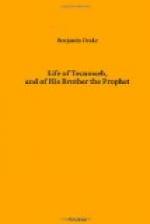[Footnote A: Stephen Ruddell’s manuscript account of the Shawanoes, in possession of the author.]
[Footnote B: John Johnston.]
[Footnote C: Mitchell.]
One mode of ascertaining the origin of the Indian tribes, and of determining their relation to each other, as well as to other races of mankind, is the study of their language. This has, at different times, engaged the attention of several able philologists, who have done much to analyze the Indian languages, and to arrange in systematic order, the numerous dialects of this erratic people. The results of the investigation of one[A] of the most learned and profound of these individuals, may be summed up in the three following propositions:
1. “That the American languages in general, are rich in words and in grammatical forms, and that in their complicated construction, the greatest order, method and regularity prevail.
2. “That these complicated forms, which I call poly synthetic, appear to exist in all those languages, from Greenland to Cape Horn.
3. “That these forms appear to differ essentially from those of the ancient and modern languages of the old hemisphere.”
[Footnote A: Mr. Duponceau.]
In a late learned dissertation[A] on this subject, it is stated that in nearly the whole territory contained in the United States, and in British and Russian America, there are only eight great families, each speaking a distinct language, subdivided in many instances, into a number of dialects belonging to the same stock. These are the Eskimaux, the Athapascas (or Cheppeyans,) the Black Feet, the Sioux, the Algonkin-Lenape, the Iroquois, the Cherokee, and the Mobilian or Chahta-Muskhog. The Shawanoes belong to the Algonkin-Lenape family, and speak a dialect of that language. It bears a strong affinity to the Mohican and the Chippeway, but more especially the Kickapoo. Valuable vocabularies of the Shawanoe language have been given by Johnston and by Gallatin in their contributions to the American Antiquarian Society, which may be consulted by those disposed to prosecute the study of this subject.




